What is the employee onboarding process?
The Oxford Dictionary defines onboarding as, “The action or process of integrating a new employee into an organization or familiarizing a new customer or client with one’s products or services.”
A successful onboarding process starts when the chosen candidate’s interview stops. This marks the beginning of an active engagement between the employer and the new employee.
While some businesses adopt an onboarding schedule that lasts for a day, others will integrate their new hires into the team with preboarding and onboarding processes that extend well beyond the new person’s first 90 days of employment.
Why onboarding matters
The saying, “you never get a second chance to make a good first impression” is as true for companies as it is for people. HR leaders who understand this, and optimize their onboarding to create a positive first impression with new hires, can reap a wealth of benefits, including better cultural inclusion, and increased engagement.
Improved retention
HR leaders who introduce structured onboarding, and focus on retaining their people, are more likely to avoid the high costs, lost productivity, and potential damage to their company culture that can result when people leave their jobs. People who experienced a good and structured onboarding process when they joined a company are 81 percent more likely to still be employed there one year later.
Increased productivity
Whether new hires are a direct replacement for people leaving an organization or they’ve been hired to fill new roles, it takes time for new people to get up to speed. A study by The Aberdeen Group found 54 percent of organizations with a formal onboarding process experience greater new hire productivity.
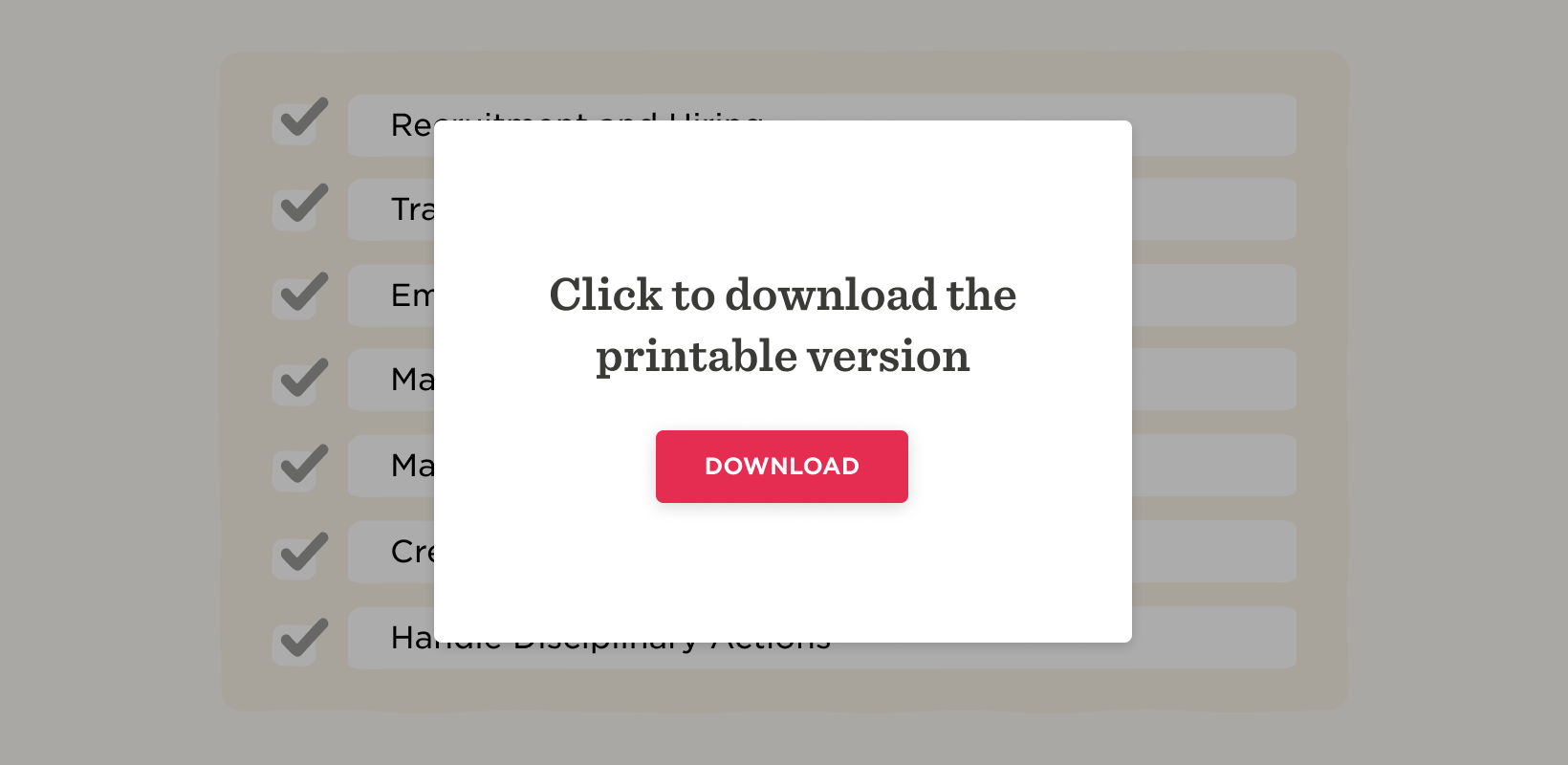
The objective of employee onboarding process
Ultimately, the objective of good employee onboarding is increased engagement, a productive workforce, and the retention of talent.
The wider business, HR professionals, and new hires all benefit when a company has a structured onboarding process.
For the business, an onboarding checklist for new hires ensures compliance with legal regulations. It ensures a system of fairness and equality, so one new hire isn’t left behind if another has a more diligent, hands-on manager. And it means new hires can start being productive and contributing to the company soon after they join.
On a wider scale, effective onboarding also helps reduce churn—so businesses can avoid the expense of recruitment.
For HR professionals, an onboarding process checklist reduces the admin associated with welcoming new people to the company—a particularly significant benefit in fast-growing companies that are bringing in new employees on a weekly basis.
When they know all the support their new hires need is in place, HR professionals can focus their time and attention on other business areas.
For new hires, when their employer follows a checklist, it creates consistency, nurturing a genuine feeling of belonging from day one.
With the support they need to start work and focus from the outset, new people can soon develop a sense of commitment to their new employer and start contributing to the bottom line.
What is an onboarding process checklist and how is it helpful?
A good onboarding process has a lot of parts that usually need to be juggled simultaneously. This is why it’s so important to have a solid procedure in place.
When creating the onboarding process for your organization, you have to make sure that you have covered five key areas: compliance, logistics, management, training, and cultural engagement.
Your organization may require additional items that are particular to your business or industry as well.
<<Download these onboarding checklists and put a solid procedure in place.>>
1. Compliance
Legal compliance and compliance with your organization’s rules, can often be completed remotely, and in large part before the new starter’s first day in the office:
- Contracts of employment
- Informing HMRC of the new employee and their tax code
- Reading company policies
- Health and safety training
- Any other legal requirements relevant to your business (e.g. non-disclosure agreements)
2. Logistics
Logistics are the basics that mean your new hire can turn up at the right place in order to do their job:
- Locations and directions, so they know where to go
- Ensuring ease of access if the employee has a disability
- Locating their desk
- Setting up their phone
- Providing a computer or helping them set up their own device for your systems
- Giving them internet access
- Getting them set up for payroll
- Giving them access to any specific systems that you use in the business – like Bob
3. Management
With good management, you’re not just allowing the new hire to do their job, you’re supporting them to get it right more quickly. This is where the hiring manager really gets involved:
- Providing relevant company and team information, like what you do and how you do it
- Setting up the new employee to use the company and team processes
(e.g., booking meeting rooms or booking holidays) - Setting objectives and goals for 30, 60, 90 days, so the new hire knows where to focus
- Adding the new employee to the company holiday calendar, and letting them know when they can start using their allocated time off
4. Training
The majority of new hires will need some training on arrival, so it’s best to consistently provide learning opportunities that will bring them up to speed quickly:
- Introduce your learning processes, systems, and policies, so the new hire knows what’s expected and that provision has been made for their development
- Carry out skills assessment to gauge knowledge and ability. This will influence their ongoing personal development plan
- Set up supervision and mentoring
- Set up any role-specific training
5. Cultural engagement
37 percent of the workforce has turned down a job offer because they felt that the culture wasn’t the right fit for them or that they wouldn’t get along with their colleagues. To get this right from day one:
- Explain company culture and values, so the new person understands your ‘why’
- Meet with their direct team, and any people they’ll work closely with on a regular basis
- Meet key people in the company, such as department heads, members of the management team, and IT support
- Help the new starter foster personal connections with the team based on work and personal interests
- Set up welcome events such as new-starter meetings with the CEO, “First Friday” after-work drinks, and welcome lunches
What should be included in your onboarding checklist?
An onboarding checklist is a way for hiring managers to organize the steps involved in guiding new hires through their first days and months at a company. Completing an onboarding checklist doesn’t necessarily translate into a successful onboarding. The goal is to let new hires know what to expect during the early days and what the company wants from them in the long run.
Onboarding checklists tend to cover:
- Recruitment process
- Role of the employee
- Goal setting
- Job training
- Introduction to company culture
- Dates for check-ins
- Meeting with other employees or superiors
- Documentation
- Learning the company’s product or service
<<Download these onboarding checklists and put a solid procedure in place.>>
Our new employee onboarding checklists
Onboarding checklist for the week before
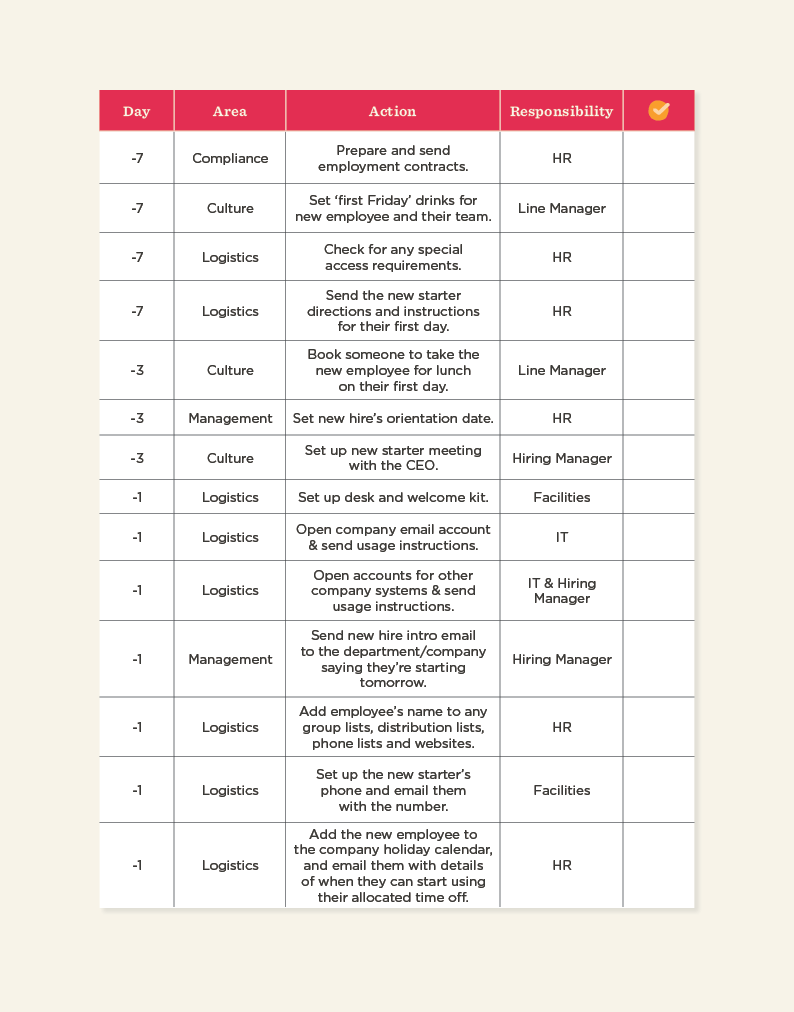
Onboarding checklist for the first day
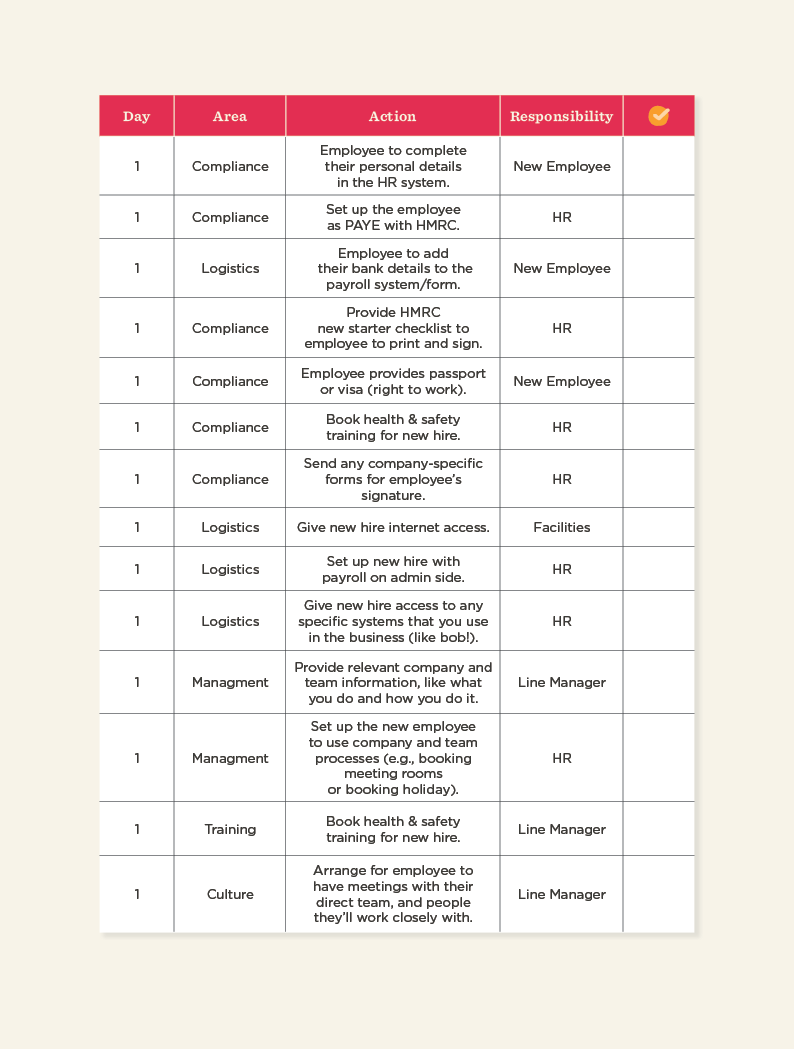
Onboarding checklist for the first week
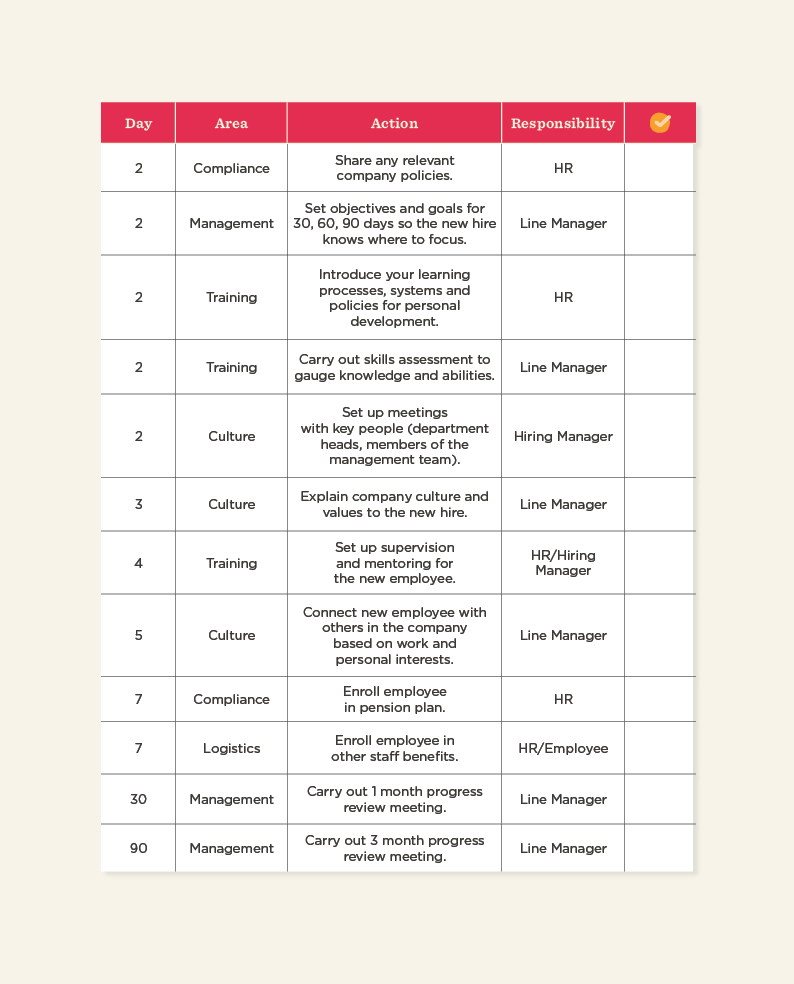
Onboarding checklists for managers
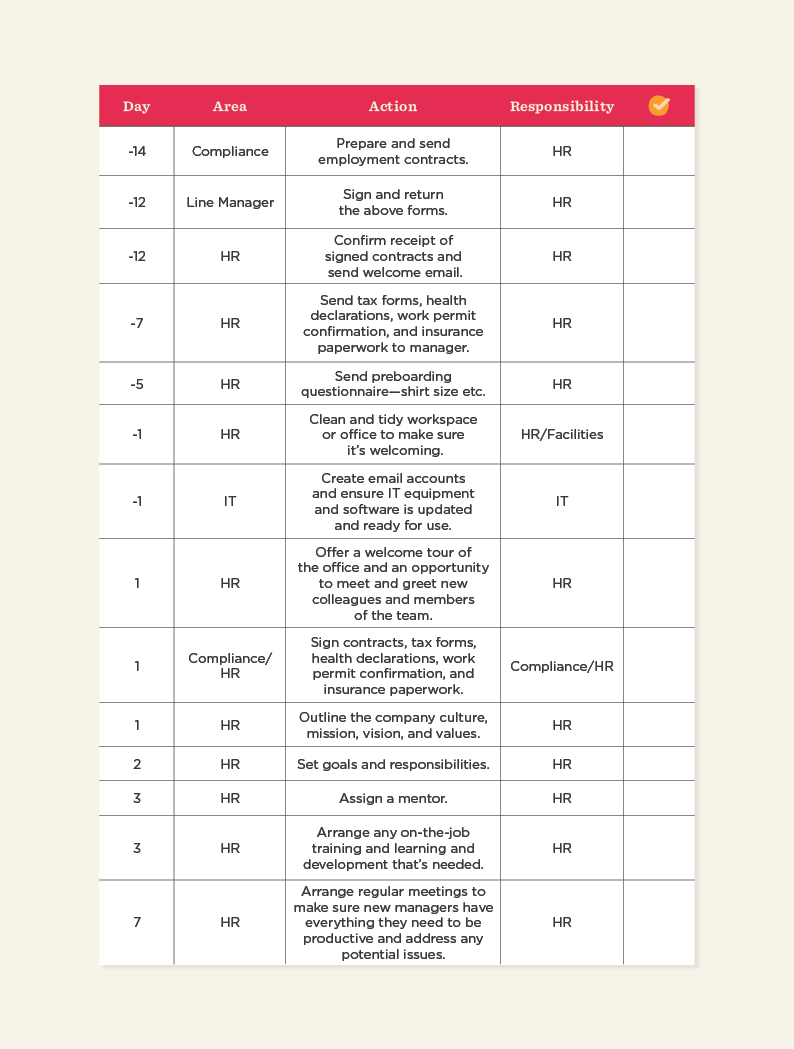
Virtual onboarding checklist
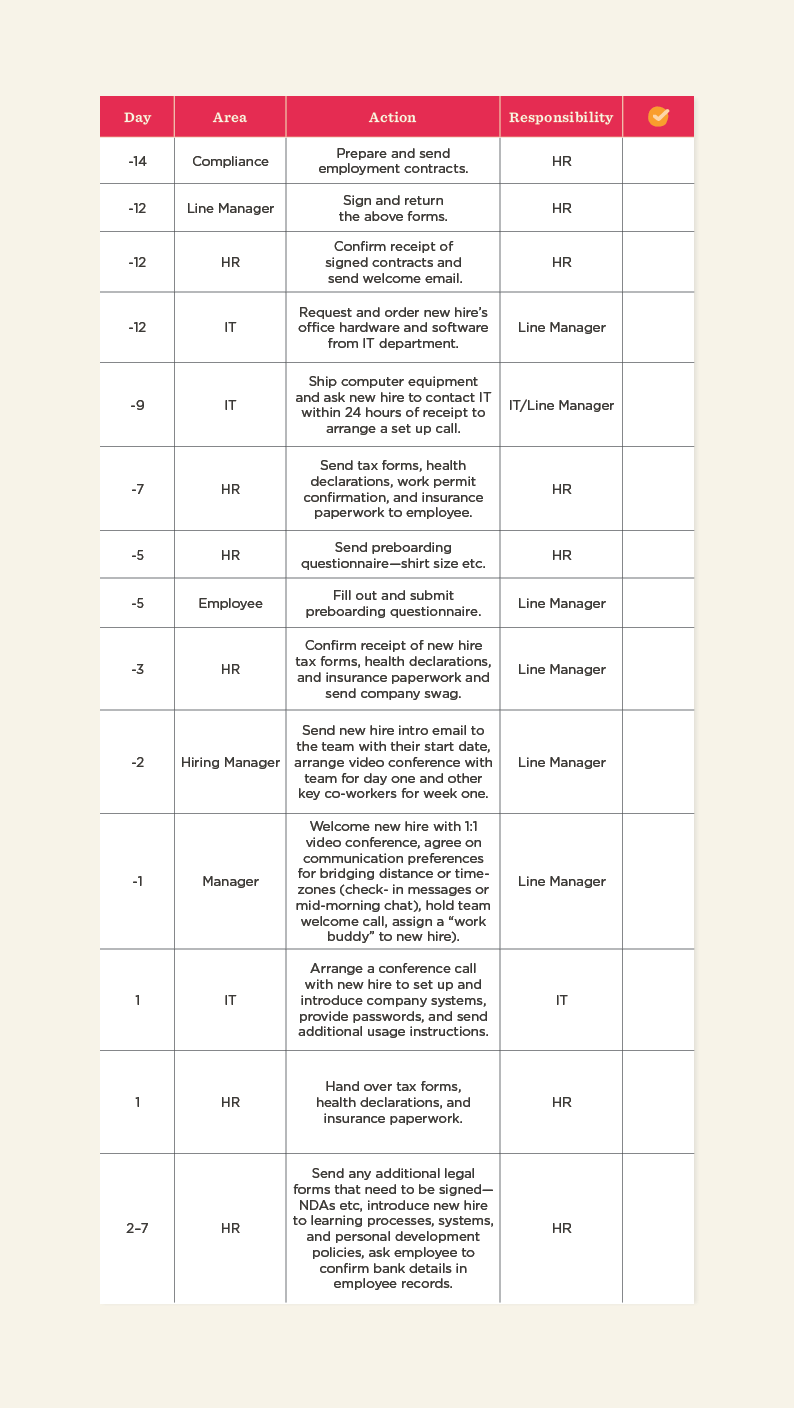
Employee onboarding documents checklist
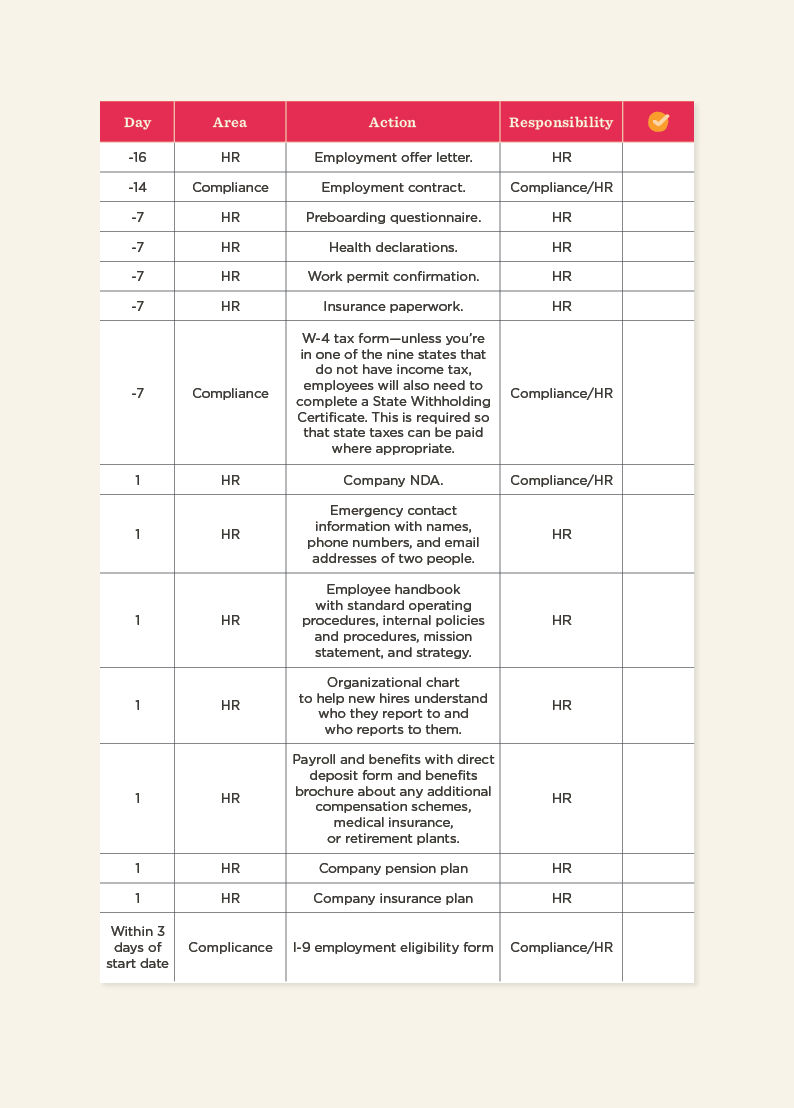
<<Download these onboarding checklists and put a solid procedure in place.>>
A nice welcome and introduction goes a long way toward helping a new hire to fit in. You can use onboarding email templates to help. Here are two essential emails that you can copy and paste. Just customize the parts in brackets:
Next steps after onboarding
After onboarding, how do you transition your new hire to the regular type of HR engagement that other people in their team receive? Do you have a plan?
Find the right time
We recommend looking at the cycle of things that you normally do with your team members and work out the best time to slot your new hire into them.
For example, if your new hire starts with you in May and you run your annual performance appraisals in June, it doesn’t make sense to have them join the process in their hiring year.
Recommended For Further Reading
Let them know what’s expected
No one likes to find out by surprise about new procedures that they have to be part of, so let them know early on what’s required.
A short email with a list, or a guide in your employee HR documents file, will mean they can refer back to it. After all, what’s second-nature to you could be completely new to them.
Meet Bob
At HiBob, we’ve built a modern HR platform designed for modern business needs—today and beyond.
We focused on building something that is robust yet intuitive and easy-to-use, which has led Bob to be the platform of choice for thousands of fast-growing modern, mid-sized organizations.
For HR, it delivers automation of many common processes, allows greater oversight and visibility of the business, and centralizes all people data in a secure, user-friendly environment.
For managers, it provides access to data and insights to help them lead more effectively and streamline processes.
For employees, it’s the tools and information they need to connect, develop, and grow throughout their journey.
